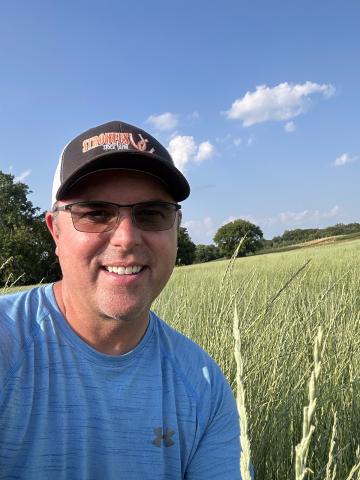
Farmers feed us. From the fresh apples we buy to the popcorn we toss in the microwave, our access to nutritious food is all made possible by the daily efforts of farmers across the nation and around the world.
But here in the US, farmers say bureaucracy makes it hard for them to grow food in a manner that is restorative for the environment. They say federal and state programs can be suffocating in their standards, and that applying for assistance programs and grants can be a difficult and lengthy process for farmers who are already managing the day-to-day tasks of the farm.
Green America’s Soil Carbon Initiative (SCI) program works to remedy some of these issues by helping farmers apply to programs that can support integrating regenerative and organic practices into their existing operations. Helping farmers transition to regenerative agriculture improves soil health, water quality, and biodiversity—and ultimately grows more nutritious food and sequesters carbon, combatting the climate crisis. Farmers accomplish this through techniques like planting cover crops and running “no till” operations that prevent erosion and increase their soil’s biodiversity, among other techniques.
Brian James in Nebraska is a fifth-generation farmer who is transitioning his operation to run on regenerative agriculture practices. His family operates farmland in southeast Nebraska and northwest Kansas, growing a wide variety of crops like corn, soybeans, wheat, and milo (grain sorghum), and raising cattle.
North of James, John Strohfus of Minnesota spent most of his career in the IT industry before returning to the family farm. He uses his land for a little bit of everything—horse boarding, cattle grazing, growing hay and crops, and hemp production for his company Field Theory Hemp. Both Strohfus and James are enrolled in SCI, restoring healthy soils to their land and pursuing regenerative agriculture. They’re acting now— not waiting around for help from Washington.

We interviewed both farmers to get a read on whether government policies help or hinder farmers on the forefront of the regenerative transition. Taylor Herren and Julie Davenson, Green America’s SCI farm program specialist and farm finance specialist respectively, also offer their expertise in agriculture policy to illustrate what Green America is doing to improve the agriculture industry.
The interview has been edited for length and clarity.
The Farm Bill comes up for renewal every five years and 2024 is the year it gets reviewed again. But this time it's an election year. Is that cause for concern?
Herren: Because it’s an election year, it’s not going to get pushed through until the very last minute. Government payments are a normal part of a farm’s revenue stream, and without renewal by the fall, many Farm Bill programs will stop.
Strohfus: It’s going to be a really bad year for farmers [in terms of uncertainty about continuing federal programs and incentives. Legislators don’t want] to put a policy in place for someone to be critical of ahead of the election.
Davenson: For example, some Republican members of Congress have proposed cutting the provisions in the Farm Bill that ensure recipients of Supplemental Nutrition Assistance Program (SNAP) benefits can use them at farmers’ markets to access healthy regenerative and organic food. This could reduce farmers’ income, but it’s not something we’ll likely know about until the last minute.
Farmer assistance programs referenced in this article:
EQIP: The Environmental Quality Incentives Program is a US Department of Agriculture (USDA) program that provides financial and technical assistance in planning and implementing conservation practices.
CSP: The Conservation Stewardship Program is a USDA program that
provides financial and technical assistance in maintaining and improving
conservation practices.
CSCP: The Climate Smart Commodities Program, enacted under the
Inflation Reduction Act, finances pilot projects for climate-smart practices
like regenerative agriculture in US agricultural and forestry projects.
How are current US farmer-assistance policies affecting your ability to transition to regenerative agriculture?
Strohfus: As a new farmer coming from the IT industry, it was astounding to me the amount of paperwork, overhead, and bureaucracy that is involved with farming. Today’s farmers have to be technologically smart, excellent managers, excellent risk/reward takers, and good communicators to talk with lenders and salespeople.
I have a lot of ways that I would use grant money really well to develop markets and work in this food supply chain resiliency side of our food company. But I don’t have time to find the grant, formulate a proposal in the right language, and get it done. And there’s a lot of bigger companies, that have those resources, that are glomming on to millions and millions of dollars.
Herren: This is a problem for lots of farmers. Programs like the Climate Smart Commodities Program through the Inflation Reduction Act are highly competitive and complex grant programs. You essentially need to be a grant writer to get that kind of money. Companies will have those kinds of resources that many farmers don’t. SCI assists farmers in applying for these grants. But ideally, we would want to see the next Farm Bill include provisions that would make these programs easier to apply to.
Davenson: And unfortunately, a lot of the programs that could help farmers like John have been one-time funding opportunities. The Regional Food Infrastructure Grant is one-time for 2024; the Organic Market Development Program was offered one time in 2023. Making both programs permanent would go a long way in supporting farmers like John to build markets for specialty crops.
Demand a Farm Bill that supports regenerative agriculture and soil health. Sign the Regenerate America petition!
Green America’s Soil & Climate Alliance is an implementing partner of Regenerate America.
Do permanent programs, like the Environmental Quality Incentives Program (EQIP) or the Conservation Stewardship Program (CSP) [see box above] pose similar challenges? Aren’t lots of farmers using these programs to fund conservation practices, which support regenerative practices?
Herren: Many SCI farmers have been or are enrolled in EQIP or CSP programs. But oftentimes, the most innovative farmers may find their practice or approach is not fully supported by US agricultural policy, meaning their conservation practices are ineligible for funding under the EQIP and CSP programs. And it is a lengthy and bureaucratic process to add or change a practice in the program.
James: With our transition, we’re not enrolled in the EQIP or CSP programs. We’re just doing it off our own dime mostly, because that way we can do it the way we want to, and plant the species we want to, or terminate [processes] when we need to. [The challenge is that] it’s hard to fit regenerative agriculture in a box when you’re dealing with biology and living systems. What works on our farm in Nebraska doesn’t work in Kansas and vice versa—let alone trying to find a program that works across the whole country.
What do you hope for, in the next year or so, for your farm? What do you hope for the nation?
James: For James Farms, in the next five to ten years, I hope to have every acre covered with cover crops [which helps prevent soil erosion; improves soil health; controls pests, weeds, and diseases, and increases biodiversity]. I want to have every field working in a more regenerative manner. I’m excited to keep working towards that.
For the country as a whole, I hope that regenerative practices become more widely adopted. Something as simple as incorporating no-till practices and cover crops. But we can’t have the government just say ‘everybody has to start planting cover crops!’ No one likes to be told what to do.
How do we get through those defensive reactions?
James: Education will be the way that grows the fastest, and just seeing their neighbors have success with it.
In my direct neighborhood, there’s a few guys trying [regenerative]. We were the first ones trying it. I think people thought we were crazy. And then last year, our neighbor told me he did some in his own field. I’ve got two other neighbors that have asked me about it, and they planted some too.
Herren: Farms like Brian’s exist all over the country. They are doing regenerative agriculture meaningfully, with cash crops like corn and soy. The more success they have, the more regenerative practices will ripple throughout their communities. SCI can assist these farmers without the help of Washington. And if good things come out of the Farm Bill, that is great and will bolster our work, but we are moving forward anyway.
How can Green Americans show support for government policies that advance regenerative agriculture?
Davenson: Ask your elected officials what they are doing to pass a Farm Bill that listens to farmers’ needs. We need a Farm Bill to pass this year so programs can continue, and we need that bill to support regenerative and organic agriculture practice and provide assistance that farmers need, like application processes for grants and assistance. Our Soil & Climate Alliance network partner Steven Keleti at Nerds for Earth does an excellent job tracking state-level policy, so people can engage with their state legislators.
Questions to ask candidates:
- What policies do you support including in the next Farm Bill, and how would they help farmers in our area?
- Would you support preserving the Farm Bill’s provision for SNAP program participants to spend their benefits at local farmers’ markets on nutritious foods grown with organic and regenerative practices?
- How would your agriculture policies incentivize farming practices that promote soil health?
- Would you support proposals for making government assistance programs for farmers like EQIP and CSP easier to access?
- The average American farmer is 58 years old, and beginning farmers struggle with equitable access to land as corporations buy up farmland and drive up prices. Would you support the Farm Land for Farmers Act, introduced by Sen. Cory Booker (D, NJ) to regulate corporate ownership of agricultural land?







